Boréal 44
Sailboat specifications
The Boréal 44 is a 45’4” (13.8m) cruising sailboat designed by Jean-François Delvoye (France). She is built since 2009 by Boréal (France).
Boréal 44's main features
- Model
- Boréal 44
- Hull type
- Monohull
- Category
- Offshore cruising sailboat
- Sailboat builder
- Sailboat designer
- Country
- France
- Construction
- Hull and deck: aluminum
- First built hull
- 2009
- Last built hull
- Still in production
- Appendages
- Centerboard : pivoting centerboard
- Helm
- Single helm wheel
- Rudder
- Single spade rudder
- Unsinkable
- No
- Trailerable
- No
- EC design categoryiThe CE design category indicates the ability to cope with certain weather conditions (the sailboat is designed for these conditions)
A: Wind < force 9, Waves < 10m
B: Wind < force 8, Waves < 8m
C: Wind < force 6, Waves < 4m
D: Wind < force 4, Waves < 0,5m - A
- Standard public price ex. VAT (indicative only)
- About434 000 €(2020)
Boréal 44's main dimensions
- Hull length
- 45’ 4”13.8 m
- Waterline length
- 38’ 2”11.63 m
- Beam (width)
- 14’ 1”4.3 m
- Waterline beam (width)
- 11’ 2”3.4 m
- Draft
- 8’ 1”2.48 m
- Draft when appendages up
- 3’ 4”1.02 m
- Mast height from DWL
- 60’ 6”18.45 m
- Light displacement (MLC)
- 22994 lb10430 kg
- Maximum displacement (MLDC)
- 27227 lb12350 kg
- Ballast weight
- 8378 lb3800 kg
- Ballast type
- Lead
Boréal 44's rig and sails
- Upwind sail area
- 1076 ft²100 m²
- Mainsail area
- 484 ft²45 m²
- Genoa area
- 592 ft²55 m²
- Staysail area
- 237 ft²22 m²
- Rigging type
- Cutter Marconi masthead
- Rotating spars
- No
- Number of levels of spreaders
- 2
- Spreaders angle
- Swept-back
- Standing rigging
- 1x19 strand wire continuous
Boréal 44's performances
- Upwind sail area to displacementiThe ratio sail area to displacement is obtained by dividing the sail area by the boat's displaced volume to the power two-thirds.
The ratio sail area to displacement can be used to compare the relative sail plan of different sailboats no matter what their size.
Upwind: under 18 the ratio indicates a cruise oriented sailboat with limited performances especially in light wind, while over 25 it indicates a fast sailboat. - 226 ft²/T20.95 m²/T
- Displacement-length ratio (DLR)iThe Displacement Length Ratio (DLR) is a figure that points out the boat's weight compared to its waterline length. The DLR is obtained by dividing the boat's displacement in tons by the cube of one one-hundredth of the waterline length (in feet).
The DLR can be used to compare the relative mass of different sailboats no matter what their length:
a DLR less than 180 is indicative of a really light sailboat (race boat made for planning), while a DLR greater than 300 is indicative of a heavy cruising sailboat. - 188
- Ballast ratioiThe Ballast ratio is an indicator of stability; it is obtained by dividing the boat's displacement by the mass of the ballast. Since the stability depends also of the hull shapes and the position of the center of gravity, only the boats with similar ballast arrangements and hull shapes should be compared.
The higher the ballast ratio is, the greater is the stability. - 36 %
- Critical hull speediAs a ship moves in the water, it creates standing waves that oppose its movement. This effect increases dramatically the resistance when the boat reaches a speed-length ratio (speed-length ratio is the ratio between the speed in knots and the square root of the waterline length in feet) of about 1.2 (corresponding to a Froude Number of 0.35) . This very sharp rise in resistance, between speed-length ratio of 1.2 to 1.5, is insurmountable for heavy sailboats and so becomes an apparent barrier. This leads to the concept of "hull speed".
The hull speed is obtained by multiplying the square root of the waterline length (in feet) by 1.34. - 8.28 knots
Boréal 44's auxiliary engine
- Engine(s)
- 1 inboard engine
- Engine(s) power (min./max.)
- 55 HP / 75 HP
- Fuel type
- Diesel
Boréal 44's accommodations and layout
- Cockpit
- Closed aft cockpit
- Cabin(s) (min./max.)
- 2 / 3
- Berth(s) (min./max.)
- 4 / 8
- Head(s)
- 2
- Freshwater tank capacity
- 200.8 gal760 liters
- Fridge/ice-box capacity
- 26.4 gal100 liters
- Boiler capacity
- 10.6 gal40 liters
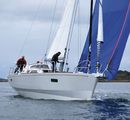
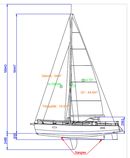

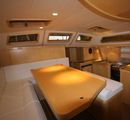

Boréal 44 interior and accommodations - - 4/9
Picture extracted from the commercial documentation © Boréal
Picture extracted from the commercial documentation © Boréal
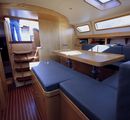

Boréal 44 interior and accommodations - - 5/9
Picture extracted from the commercial documentation © Boréal
Picture extracted from the commercial documentation © Boréal
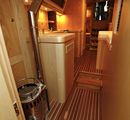

Boréal 44 interior and accommodations - - 6/9
Picture extracted from the commercial documentation © Boréal
Picture extracted from the commercial documentation © Boréal
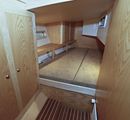

Boréal 44 interior and accommodations - - 7/9
Picture extracted from the commercial documentation © Boréal
Picture extracted from the commercial documentation © Boréal

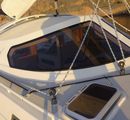
Similar sailboats that may interest you:
Sailboats
First built hull
Hull length
1993
44’13.4 m
2007
44’ 6”13.57 m
1989
45’ 4”13.8 m
2008
46’ 7”14.2 m
2010
47’ 8”14.55 m
1988
52’ 6”16 m
2016
44’ 11”13.68 m
2016
44’ 4”13.5 m
2000
52’ 6”16 m
2017
50’ 11”15.51 m
2010
45’13.72 m
2017
47’ 4”14.43 m
2012
47’ 4”14.43 m
2016
46’ 10”14.25 m
2018
45’ 11”13.99 m